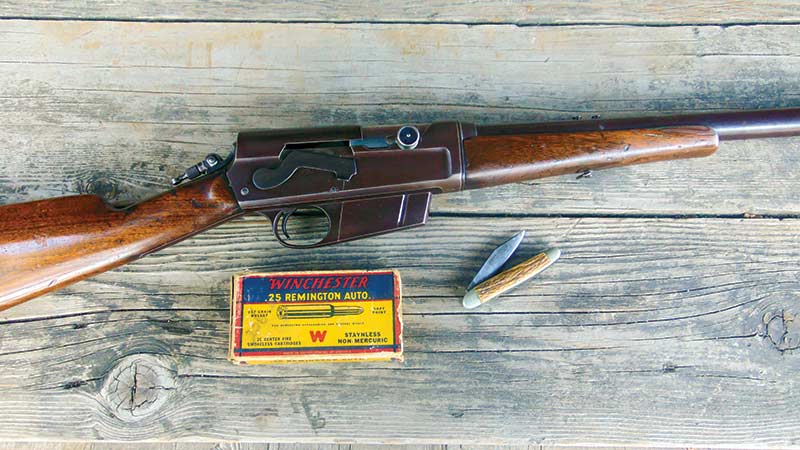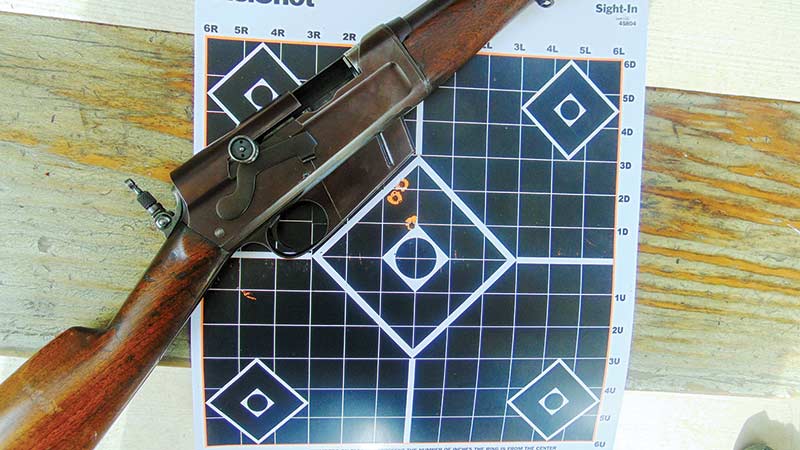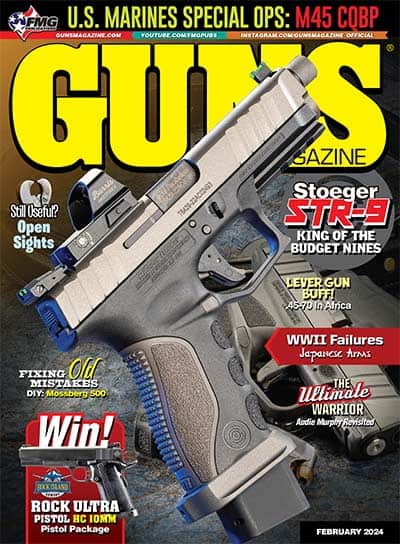Remington Model 8
Early Auto-Awesomeness
Sometimes, a particular firearm can flat-out grab your attention just by the way it looks. For many of us, such models might include the P-08 Luger, Mauser C96 “Broomhandle,” Mannlicher-Schonauer M1903 and Savage M99. But here’s another — and one with a 42-year production span to boot — although some might opine that its looks are a bit, well, industrial.
Besides being one of the most distinctive-looking rifles ever produced, Remington’s Model 8 had the distinction of being the first successful (commercially speaking) semi-auto rifle offered to American hunters. Like so many classic and enduring platforms, the Model 8 was designed by — insert drum roll here — John Moses Browning.
Big Screen Bang
However, I first became aware of the Model 8 in the early 1960s when I saw Warren Oates using one in Sam Peckinpah’s Western classic Ride the High Country, an admittedly avant garde hardware departure from the usual Winchester lever gun.
A few years later, a guy I was deer hunting with was using one. I was intrigued by it but wasn’t able to actually shoot one until years later. There’s simply no way of ever mistaking it for anything else. The first time I saw one, I thought it registered off the charts in terms of the Cool Factor. I still feel that way.
In terms of real-world historical significance, the Model 8 was used by legendary Texas lawman Frank Hamer in both .25 and .35 caliber. In fact, Hamer was carrying a .35 with an extended magazine when he and other lawmen ended the careers of Bonnie and Clyde near Gibsland, La. And, prior to propeller-synchronized machine guns in World War I, French pilots employed the Model 8 as an “air-to-air” solution to deal with German planes early in the conflict.
The Model 8 is a long-recoil-operated rifle featuring a 22″ barrel encased in a sheet metal jacket giving the barrel a straight-taper beefy appearance. It has a fixed, non-detachable 5-round magazine just forward of the trigger guard while larger-capacity mags for LE use could be retro-fitted. The large distinctive-looking safety design was later “appropriated” in the decidedly un-sporting AK-47 by no less a small-arms icon than Mikhail Kalashnikov.
The rifle was introduced as the Remington Autoloading Rifle in 1905 and officially became the Model 8 in 1911. The Model 8 morphed into the Model 81 Woodsmaster in 1936 and remained in production in various grades until 1950 and included a .300 Savage chambering.
Visual cues distinguish the Model 8 from the Model 81. The M8 has a straight-grip stock and a slender forend while the M81 has a pistol-grip stock and a beefier beavertail-style forend.
The Model 8 was significant as it served as the original launching pad for Remington’s family of rimless cartridges, the .25, .30, .32 and .35. The first three were, for all practical purposes, ballistically identical to Winchester’s .25-35, .30-30 and .32 Special. However, the potent .35 Remington — which was pretty much a “stand alone” item — still exists commercially. A Model 8 so chambered is considerably more desirable today for anyone interested in easily obtained store-bought ammo.
Our particular Model 8, courtesy of collector/auction addict Doug Fee, was chambered in .25 Remington and featured a folding factory tang peep sight. The .25 Remington launches a 117-grain softpoint at a claimed velocity of just under 2,400 fps. This is on a par with the .25-35 Winchester, a round that once served me well on a Texas whitetail/hog/javelina hunt. No, it’s not up there power-wise with a .30-30 but it worked very well for stuff at short to medium range.
Up to now, my only previous experience in shooting a Model 8 had been with one in .35 Remington. I’ve heard it said the unique action of the Model 8 is a bit unkind recoil-wise, but the .35 version — while reasonably stout — was by no means unbearable when launching a 200-grain bullet at somewhere in the neighborhood of 2,100 fps.
In comparison, the .25-caliber Model 8 with a 117-grain bullet around a similar speed was fairly negligible in terms of felt recoil.
Clearing The Cobwebs
The ammo we had was vintage, to say the least, consisting of 117-grain Remington Core-Lokt and Winchester SP. Both were well in excess of 75 years old. According to our chronograph, neither reached the claimed velocity of just under 2,400 fps. The Remington stuff we had clocked 2,060 fps; the Winchester averaged 2,073 fps.
But even with an 8-lb. rifle sporting a “pad-less” curved butt plate, shooting was easy. The rifle produced the distinctive, long-recoil ka-chunk familiar with anyone who’s ever shot a Browning A5 or Remington Model 11 shotgun. The trigger, incidentally, was excellent and crisp, a “bolt-action”-type at 3 lbs. Using the folding aperture rear, our best 3-shot group at 50 yards was slightly over an inch with the Remington stuff.
Our range session was facilitated by the fact we had an original 5-round stripper clip, which let us avoid a bit of fumbling in the reloading process. Originals can be a bit pricey, but Cogburn Arsenal (CogburnArsenal.com) offers a serviceable nylon facsimile for $2.95.
Of course, in comparison with other early “quarter bores” such as the .250-3000 or .257 Roberts, the .25 Remington comes up short in the velocity department at least by modern “speed demon” standards. It’s also pretty much a handloading proposition today. But, in the Model 8 it proved to be a delightful, easy shooting cartridge and one well-suited for whitetail at under 100 yards.






